In one of the more surprising moves of the current transfer window, Olympique Lyon Feminin have opted to bring in Wolfsburg lynchpin Sara Bjork Gunnarsdottir in what seems like a bold move. The serial winners are not resting on their laurels and are rectifying the mistakes past champions and winners have made by not adequately reinforcing their team to create a competitive atmosphere. The move to bring in Gunnarsdottir to challenge two of the best defensive midfielders in Amandine Henry and Saki Kumagai does just that. So, the question remains, what does Gunnarsdottir bring to Lyon and does she start over one of the existing midfielders?
Through this scout report, I will be detailing the tactical intricacies and ideologies of Lyon’s midfield and how Gunnarsdottir fits in.
Player profile
Sara Gunnarsdottir is a 29-year-old Icelandic midfielder who till recently plied her trade in Germany with VFL Wolfsburg where she spent four years. Naturally a defensive midfielder, Gunnarsdottir is a gifted player who can operate from box-to-box with an all-around ability to make an impact in both boxes. The defensive midfielder’s main attributes include her passing and tactical intelligence which contribute towards her vision, defensive capabilities, and goal-scoring threat. Being at the base of midfield means Gunnarsdottir is responsible for build-up and screening the defence which is an important aspect of Wolfsburg play. In 63 appearances for the German champions, Gunnarsdottir has scored 12 goals, a good return for a player in her position. To further emphasise her goal-scoring exploits, she scored 34 goals in 110 appearances for FC Rosengard. It is not uncommon to see Gunnarsdottir make bursts forward into the 18-yard box to get on the end of passing moves and switch gears to get back and cover for counter-attacks. Now through this tactical analysis, I will explore these skills and analyse them further breaking it up into her attacking, defensive, and transition phase.
Defensive phase
Gunnarsdottir defensive style of play was more based on her work off the ball than on it. Gunnarsdottir relies on her excellent positioning and proactiveness to thwart any dangerous attacks Wolfsburg faced. Wolfsburg operate using three active formations including the 4-2-3-1 (39%), 4-4-2 (34%), and 4-3-3 (16%), in each of these formations Gunnarsdottir will occupy one of the holding midfield roles with a license to roam between both boxes. Her role is to disrupt, intercept, and dictate possession for Wolfsburg and prevent teams from getting into their 18-yard box.
Because of her box-to-box style and Wolfsburg’s possession dominant nature, Gunnarsdottir doesn’t engage in many defensive duels but rather anticipates her opposition’s intention and move to block passing lanes and force them into what she wants them to do, especially in the defensive third. Gunnarsdottir isn’t the best tackler and if she doesn’t have support near her, players can seemingly get past her. Sometimes when she aggressively goes in, players with quick feet often get the ball away. Where she does excel is when Gunnarsdottir gauges her surroundings and adjusts her position accordingly to prevent players from advancing without getting in too close. This sort of anticipation is extremely useful and makes up a strong part of the defensive midfielder’s repertoire.
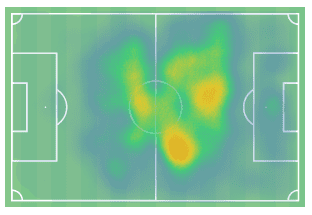
Analysing Gunnarsdottir’s heat map above, we can see that while there is a major activity in the forward areas, she is equally present in the defensive third showing her box-to-box role. Not many teams will trouble Wolfsburg for possession but they must be wary of counter-attacking teams and turnovers in midfield. This is where Gunnarsdottir’s defensive role comes into play. Gunnarsdottir’s defensive duels/90 is indicative of this with 4.75 with a 53% success rate.
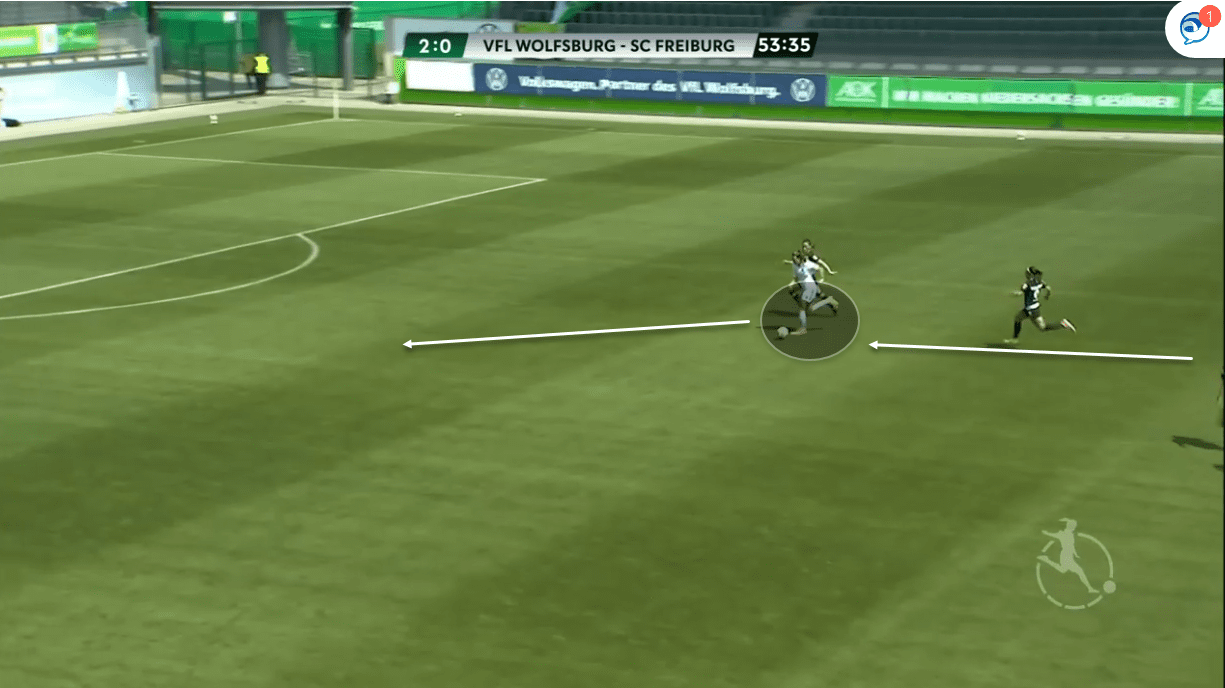
If we take a closer look at this example, Freiburg are counter-attacking Wolfsburg with Gunnarsdottir the closest one to the attacker in the previous frame. Here the Icelandic midfielder manages to catch up and starts to get around her to try and shepherd her away from the goal to wait for support. We can see that Gunnarsdottir isn’t pressing up against the player but rather keeping some distance to apply just enough pressure to control her actions.
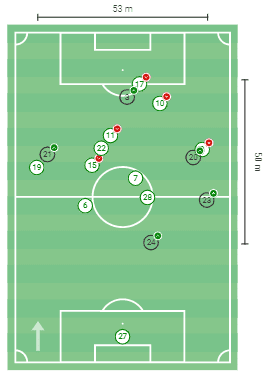
Just to further emphasize the correlation between Gunnarsdottir’s higher positioning and Wolfsburg’s higher possession, the above positions map from Wolfsburg’s game against Essen illustrates this. Gunnarsdottir (#7) was playing as the deepest lying midfielder yet her average position is above the halfway line. It shows Wolfsburg’s dominance which is something mirrored in Lyon’s play too. In this case, Gunnarsdottir should be able to slot into the side easily.
Transitional & attacking phase
Playing in such an attacking team in Wolfsburg, Gunnarsdottir’s main role was to provide balance alongside Claudia Neto. However, Gunnarsdottir was also a prevalent presence in the attacking third through her transitional and attacking play. In this section, I will discuss the role the Icelandic midfielder played in the final third of Wolfsburg’s team and how this translates into Lyon’s. More than attacking, Gunnarsdottir is much more involved in the transitional phase with her attacking contributions more about supporting the forward line.
Wolfsburg play a very attacking lineup and operate in an almost 3-1-6 formation where the attacking talents would overwhelm opposing defences. One of Neto or Gunnarsdottir will join the attack with Gunnarsdottir a player who would both link play outside the 18-yard box and make off the ball runs into the box. Her attacking style may not seem very potent but her whole game is predicated on finding spaces between lines and making runs into the box. During build-up, Gunnarsdottir can at times be seen dropping in to support her central defenders in receiving passes to bypass higher pressing from opposing players.
The two phases intertwine as she combines her passing and defending ability to transitions from one third to another after which she attempts to make runs forward to make herself available in space. The data gives us an insight into her influence going forward. She averaged 9.09 forward passes/90 (81% success rate) and has 3.16 touches in the box/90 which is quite high for a defensive midfielder. The standout statistic here is the higher touches in the box, which illustrates Gunnarsdottir’s forward movement and presence, especially from a deeper position. Most of these passes are quite simple, but important because it keeps Wolfsburg ticking and allows the more creative players to move into position. Gunnarsdottir joins the attack by placing herself in the 18-yard box ready to pounce on any opportunities presented to her.
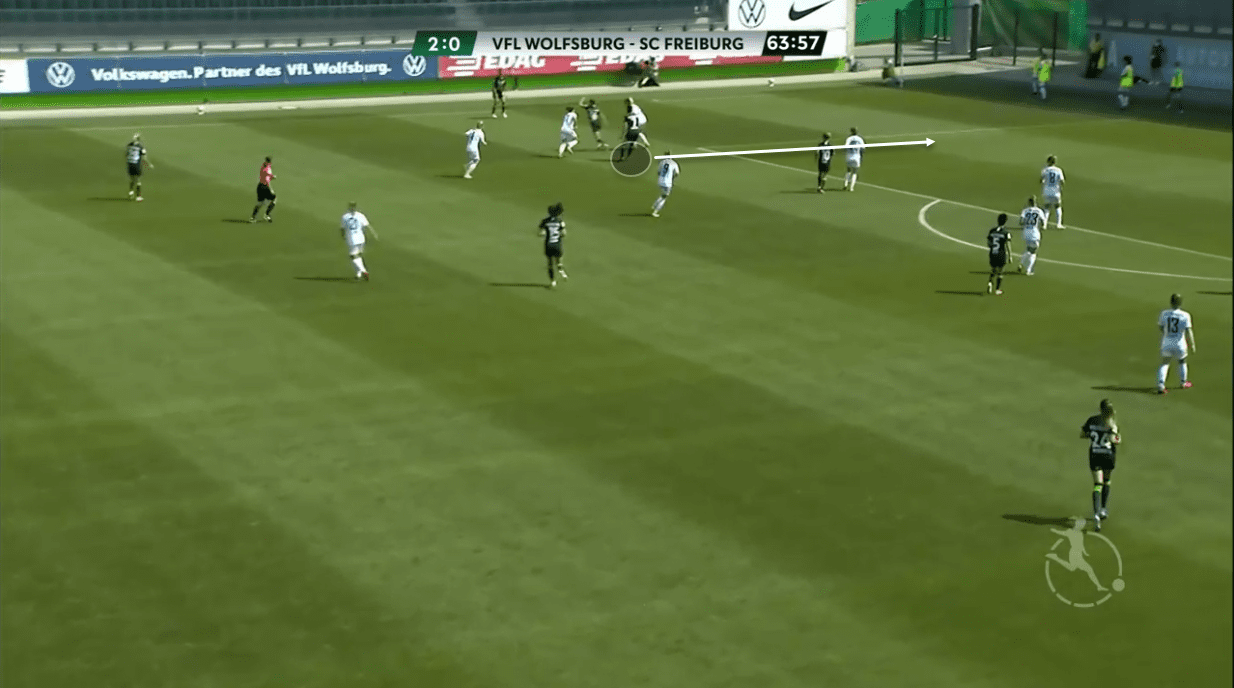
We can see an example of this in the game against Freiburg in the Frauen-Bundesliga. Gunnarsdottir is positioned high and once the ball is passed out wide she starts stepping away from the two opposing players. At this point, she already knows she wants to attack the vacant space.
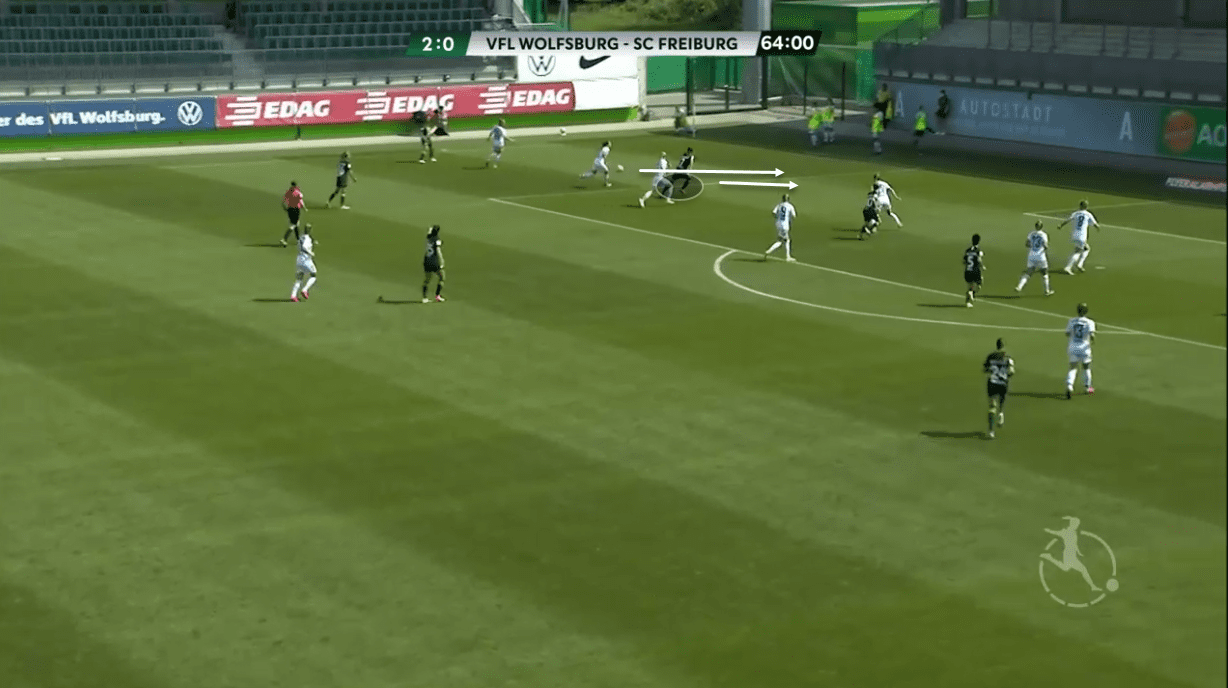
Gunnarsdottir capitalised on the distraction of the two Freiburg defenders and manages to time her run and get ahead of them. Gunnarsdottir showcased her tactical intelligence here where she has created an extra yard and second to collect the ball and pick out one of her teammates in the middle. Her positioning and timing is what makes her such a dangerous asset in the final third and helps to breakdown resolute defences. Similar to Wolfsburg, Lyon also face stubborn defences where they rely on lots of movement from their attackers.
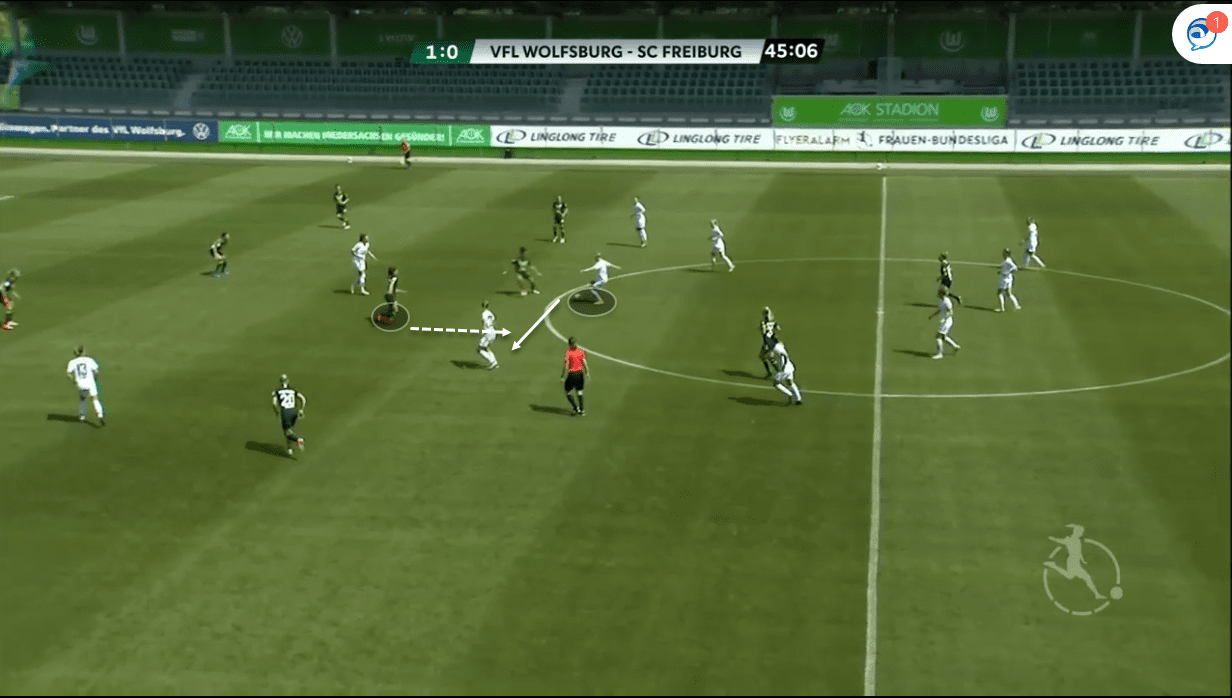
Here we can see Gunnarsdottir retreating to prevent Freiburg’s attack. In this case, the ball carrier doesn’t have too many options except to make a short pass to her left or attempt a forward dribble. Gunnarsdottir game intelligence comes on display here where she anticipates the likely pass into the highlighted player and starts stepping forward to intercept the pass which results in a turnover for Wolfsburg. What makes Gunnarsdottir so good in these situations is her ability to either win possession and initiate a counter-attack or force the opposition into making a mistake in which her teammates are able to take the ball forward.
How does Sara Gunnarsdottir fit into Olympique Lyon?
To complete this analysis, the biggest question everyone has is how does Jean-Luc Vasseur fit in three world-class defensive midfielders into his tactics that currently uses two? Well, I think we need to see the shape of the squad and analyse two points, the first is to look at squad depth to see the options available and secondly, what she offers in place of either Henry or Kumagai.
Looking at make up of the squad, we can see that Lyon do not have enough strength in quality depth in the middle of the park. Offensively, Lyon have a number of options off the bench in Shanice van de Sanden and Delphine Cascarino who can come on, on top of the starting trio of Majri, Nikita Parris, and Eugenie Le Sommer. Defensively, Wendie Renard, Kadeisha Buchanan, and Griedge Mbock Bathy are three solid central defenders and arguably where Lyon have most quality is at full-back. Lucy Bronze, Alex Greenwood, Sakina Karchaoui, and Ellie Carpenter are four high-quality full-backs with Majri able to drop into left-back if needed. However, in central defensive midfield, they lack any real quality outside of Henry and Kumagai, with Dzenifer Marozsan able to play there but is realistically an attacking midfielder. So, the move for Gunnarsdottir makes sense from a squad depth perspective allowing Vasseur to rest one of his two-star midfielders.
Defensively, Lyon’s defensive structure is based around movement and positional rotations across their midfield and wide defenders. They often use a 4-2-3-1 system where Gunnarsdottir would play in the double pivot alongside one of Henry or Kumagai. Lyon’s defensive line is higher up meaning they try to win the ball back in midfield. They employ a midfield press that heavily includes the full-backs. So Gunnarsdottir will have support in midfield and the centre-backs behind her to ensure maximum safety. Usually Bronze will drive inside to stop the midfielders from progressing the ball, whilst the left-back will ensure the centre-backs are not outnumbered and cover the area behind their position.
The constant rotations and movement from the other players around the double-pivot will help Gunnarsdottir carry out a similar to what she occupied at Wolfsburg. Kumagai and Henry will often patrol the midfield area to cover spaces and prevent opposing teams from easy passing lanes and ways through and having one of them next to Gunnarsdottir can ensure solidarity. Gunnarsdottir is an excellent player who allows the more creative, attacking players to thrive in the system by simultaneously assisting them in the final third. I also believe Gunnardottir could do even better in a midfield three to be given the freedom to be even more aggressive from deep to force mistakes and allow the other players to attack.
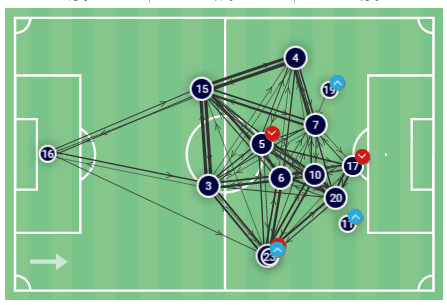
Their roles are to almost play box-to-box roles when one pushes up the other sits just behind offering protection to such a high line while the other uses their passing to affect the final third. Gunnarsdottir can easily slot into the defensive role. The graphic above dictates Lyon players’ positions and how they set up. In this game against Stade de Reims, we can see both Kumagai (#5) and Henry (#6) are in similar positions to Wolfsburg’s players in the earlier graphic, which helps Gunnarsdottir’s development.
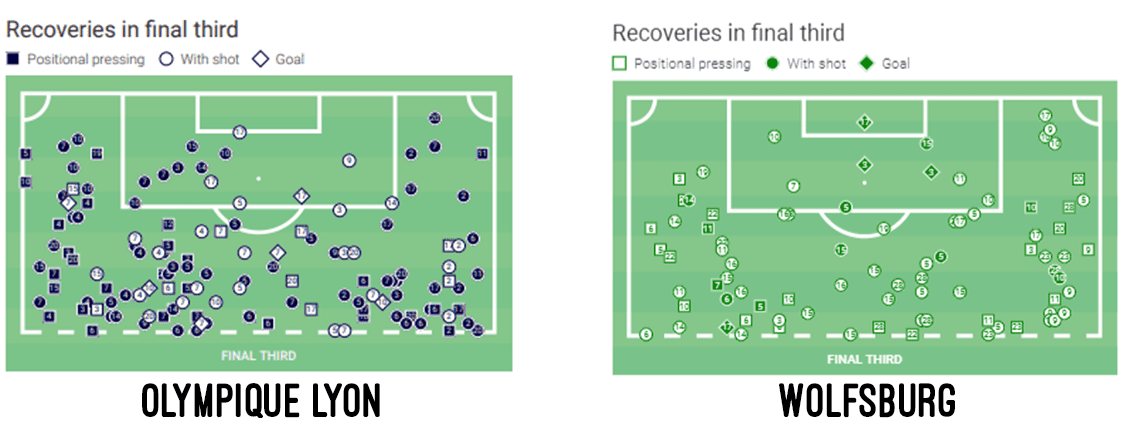
When it comes to transitions and taking the ball into the opposition half, we will start by taking a closer look at Wolfsburg’s recoveries, where we can see they have a consistent spread of tackles across the pitch in the final third which shows how active they are in this area of the pitch. If we look at Lyon’s recovery map, we can see the similarities in the areas of recovery but more importantly the number of recoveries made in the final third. Lyon are very active in the final third with Amel Majri, Kumagai, and Henry making the three highest recoveries in the sample size given. Gunnarsdottir averaged 8.54 recoveries/90 with 64.8% made in the opposition half which shows she can slot into Lyon’s system and replace either Kumagai or Henry in this capacity.
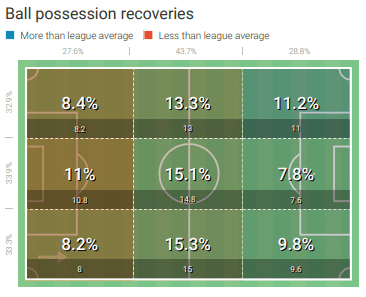
15.1% of Lyon’s ball recoveries occur in central midfield, only right midfield has more with 15.3% which shows that most of the action happens there. Kumagai has made 59 recoveries in 359 minutes of play, which shows how important the central midfielders are to Lyon’s system of winning the ball back and attacking. I don’t think Gunnarsdottir will attack as much at Lyon rather she’ll sit outside the 18-yard box and offer a passing option with Henry being more aggressive with threatening passes and crosses into the box.
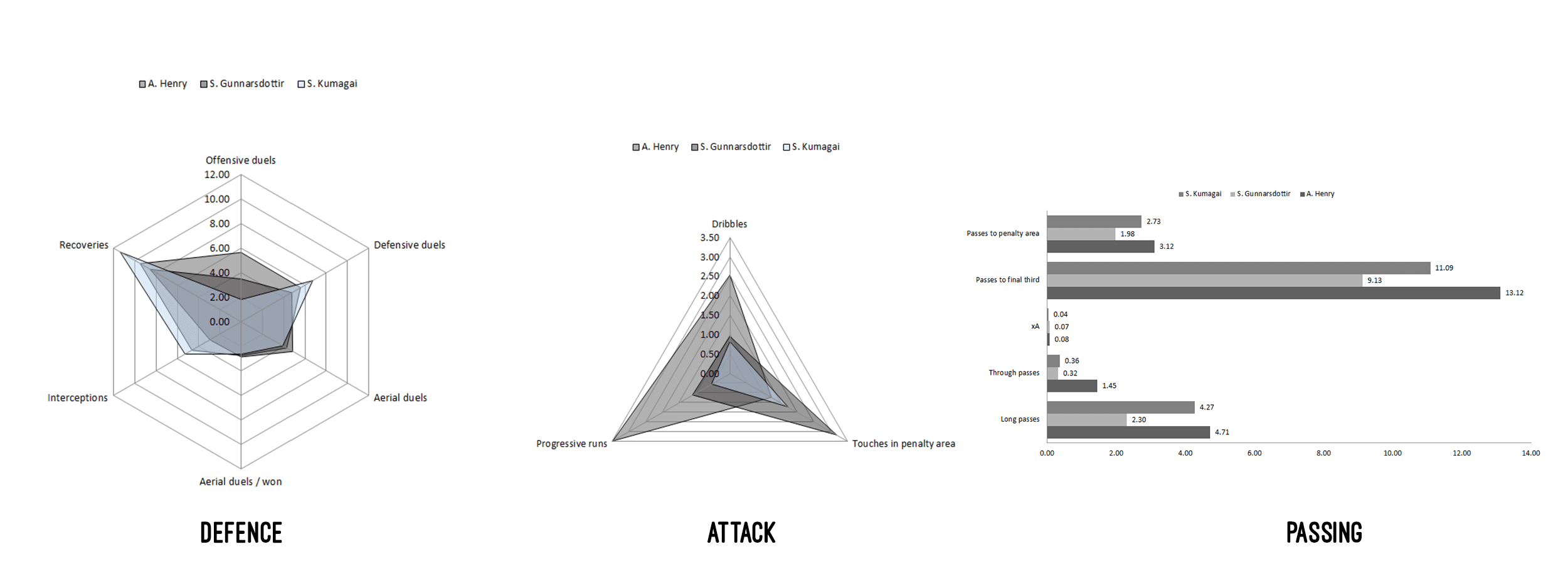
I’ve analysed Gunnarsdottir’s statistics against Kumagai and Henry to see where she thrives in comparison to her new teammates. This graphic is split between attacking, defensive, and transitional data. Starting with the defensive data, we can see Kumagai is much more prevalent here specifically in defensive duels, interceptions, and recoveries. Gunnarsdottir seems to less frequently engage in a defensive capacity.
From an offensive perspective, Gunnarsdottir has the most touches in the box illustrating her attacking capabilities through runs into the box. Henry is the most attacking player of the three and a combination of the two in midfield could be a tactical option against teams with a low block that requires the extra support in and around the 18-yard box.
Lastly, in the transition phase, we once again see Henry as the clear winner in this regard although Gunnarsdottir isn’t too far behind. Given that the French international is widely considered the top central midfielder in the world, this comes to no surprise. However, what is clear to see is Gunnarsdottir is a sort of a hybrid of Kumagai and Henry. Without being a specialist in either phase of play, Gunnarsdottir will bring her own qualities to midfield and because of this becomes a good option to partner with either Kumagai and Henry. This is also another reason I believe Gunnarsdottir could thrive in a three-man midfield. If she can combine the attacking and creative efficiency of Henry and defensive awareness of Kumagai, Lyon could have an impenetrable midfield being able to cover and attack in numbers whilst always having a player left over to protect the defensive line.
Final Remarks
Gunnarsdottir represents yet another indication that Lyon are preparing for life without some of their biggest stars. Adding in more competition to a winning squad is only healthy and will keep the current starters driven to continuously prove their worth. With Paris Saint-Germain strengthening this summer and the English clubs (Chelsea, and Manchester City) all boosting their ranks, Lyon will need to be on their heels for next season’s UEFA Champions League. Gunnarsdottir, Carpenter, and Karchaoui are three excellent editions, however, Gunnarsdottir is just the player to keep Henry and Kumagai at their absolute best whilst giving Lyon much needed quality depth in the position.






Comments